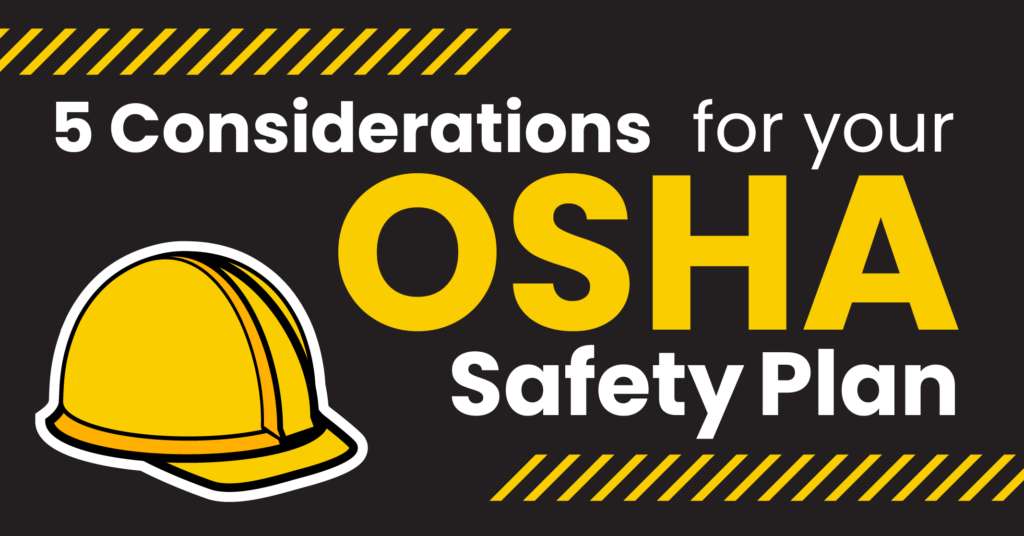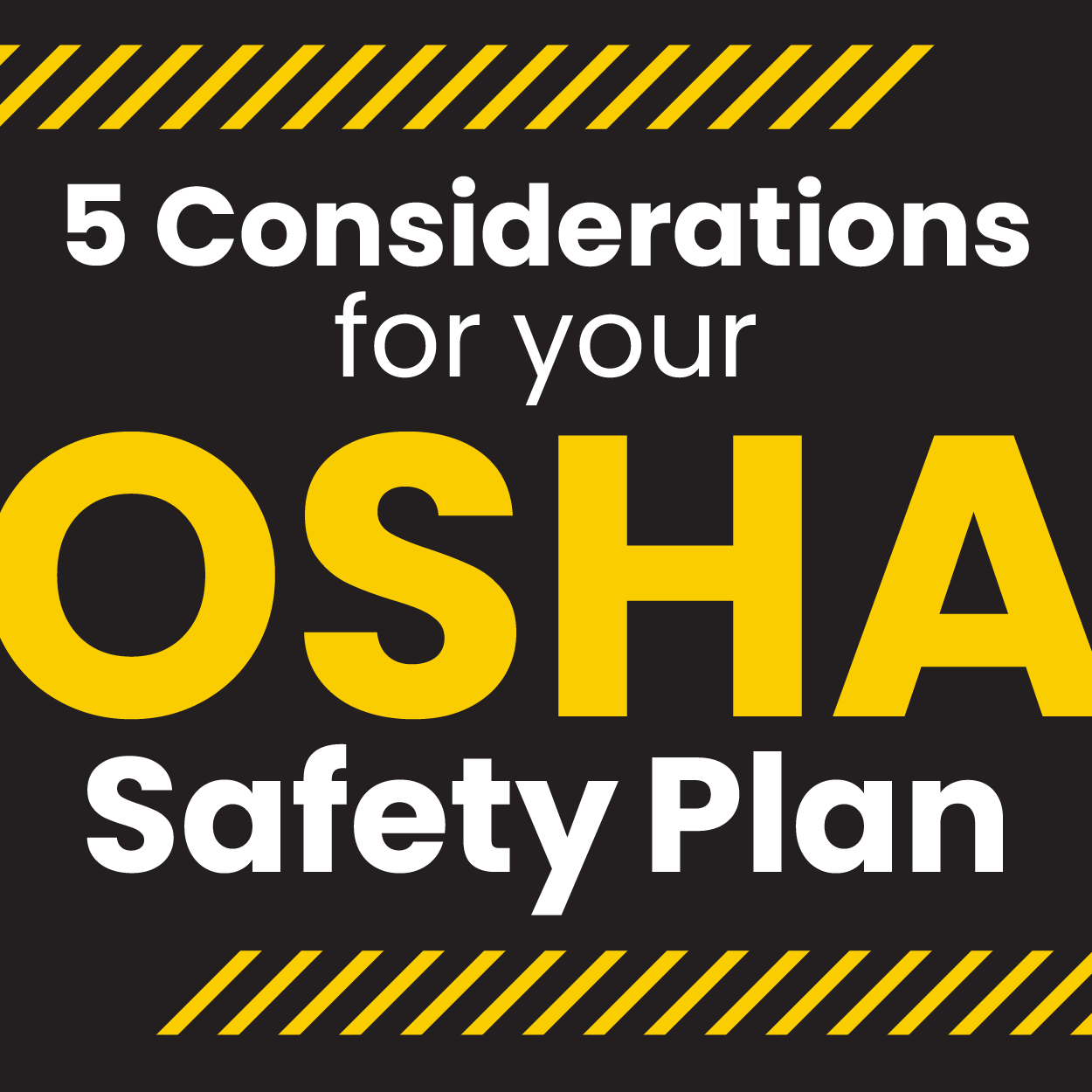
How to Build Your OSHA Safety Plan for 2021: 5 Considerations
The year 2021 brings big changes to workplace safety. Businesses are restructuring workforces as the pandemic made remote work more prevalent. A new presidential administration typically means changes in safety regulations. And even as the world starts to recover from COVID-19, the pandemic has forever transformed approaches to business safety plans. Combine this with the Department of Labor cost of living increases in OSHA penalties, and there is certainly a lot on the safety agenda for this year. So where to start? Let’s start by reviewing the 2021 plan…
A Good Safety Plan is the Key to Safer Workplaces
Trying to adapt to a new era of safety without a starting point is like trying to row upstream… without a paddle. If you believe this study from 2014, more than half of businesses are not prepared for an emergency. For sake of those businesses, let’s start with the basics: A business safety plan is documentation of safety and health hazards a business possesses and what precautions are in place to keep workers free from harm. It also details how businesses will handle accidents. Safety plans are typically kept in physical form, such as in a binder at a worksite, and can also be uploaded online for anywhere-access.
If you have more than 10 employees at your business, you legally need at least an emergency action plan and fire prevention plan in writing, according to Occupational Safety and Health Administration (OSHA) standards.
There are also more than 35 OSHA written plan, procedure, program and manual requirements for general industry, as well as more than 20 for construction. Some plans, like those under the Bloodborne Pathogen Standard, must be reviewed and updated at least annually, according to OSHA regulations. As you create or update safety plans for your business, identify safety objectives you want to aspire to. That way you can align your performance with the training and guidelines you have in place.
Why You Need a Safety Plan
Regardless of how big your company is or how many hazards it has, a written safety plan is helpful because it educates your employees and mandates consistent safety standards across your organization. You can have a safety plan for each department and/or activity where safety hazards may be present. A safety plan outlines exactly what your employees should do in case of an emergency. A safety plan also provides crucial protection for customers who might encounter hazards, as well. A workplace safety plan can lower safety incidents and workers’ compensation costs for your business. It also shows your employees you’re invested in their safety, which can make them more confident and engaged on the job. When you look at your existing plan or create a new one in 2021, here’s what to be aware of.
Need help creating or updating your safety plan? Contact YellowBird for EHS consultant services, including COVID EHS consulting.
1. Ensure Each Safety Plan Is Complete & Accessible
COVID-19 has forced businesses to rethink everything about their approach to safety. That presents an opportunity to be more thorough in your safety plan evaluations and identify improvements you can make, including looking into technology that can enhance workplace safety.
COVID-19 also affected many workers’ comfort in being at their workplace. One way employers can allay any fears is to improve the comprehensiveness of safety plans. As you review, update or create new plans in 2021, make sure each plan you have includes the following elements.
- What protective gear should be worn in an area, including gloves, hard hats and masks
- Action to take when safety is compromised or an accident occurs
- How to secure an area
- Evacuation routes
- People to contact after incidents occur and reporting/data collection procedures
- How to alert others about incidents
- Training methods
Since safety plans are living documents, use new observations to constantly improve your plans. Make employees aware that their feedback is valued and invite them to share it often. Provide updated safety training as your plans evolve. Upload safety training online so it’s easily accessible to your workforce.
2. Continue to Prioritize COVID-19 Safety Precautions
In June 2020, OSHA issued guidance for reopening business, which included conducting a hazards assessment for all jobs. Employers should communicate to employees how their COVID-19 safety efforts align with OSHA guidance and how the business plans to keep employees safe when they return to work.
According to “Safety + Health” magazine, any actions that were put in place to protect workers from coronavirus spread should be continued at least through summer 2021, when the majority of the American population is expected to have access to a vaccine. These precautions include:
- Wearing masks, facial coverings and other personal protective equipment at work
- Physically distancing at least 6 feet apart when possible
- Spacing out workstations
- Frequently handwashing
- Avoiding gatherings of large groups of people
- Implementing contact tracing programs, testing, reporting and tracking
- Eliminating shared spaces, like watercoolers or coffee stations
At a December 2020 presentation by the National Safety Council, environmental health and safety consulting firms also recommended paying special attention to keeping at-risk workers safe and supporting employees’ mental health during and post-pandemic.
Part of a business safety plan strategy in 2021 should include creating infectious disease preparedness and response plans to protect the business and employees. These plans can evolve as new threats emerge.
Also, as vaccines become more widely available, employers can recommend that their employees get vaccinated. Employers should consider the potential of having a hybrid workforce of vaccinated/non-vaccinated employees, which may require pivots in safety plans.
There are no guarantees to when the pandemic will be in the rear view of businesses and employees. Ideally, businesses should be prepared to incorporate COVID-focused precautions into their safety plans well into 2022.
3. Prioritize Mental Health
Mental health reached crisis levels in the United States in 2020. According to Mental Health America, the prevalence of mental illness among adults was increasing before COVID-19. In 2017-2018, 19% of adults experienced mental illness, a 1.5 million person year-over-year increase. Suicide and self-harm ideation, anxiety and depression all reached peak levels in 2021.
These staggering figures are important for employers to pay attention to. In addition to negatively impacting productivity and the business bottom line, mental health issues can also increase accident prevalence.
According to the Centers for Disease Control and Prevention, stress and poor mental health negatively affect employee job performance and engagement with work. A study published in “Injury Prevention and Environmental Health” found psychosocial stressors like significant mental workload and isolation increase injury risk.
Poor mental health can decrease the effectiveness of safety plans. Consider providing mental health training, offering flexible work arrangements and checking in with employees frequently to improve mental health in your workplace.
4. Create Work-From-Home Safety Plans
If you’re like many businesses that enabled employees to work from home at least part of the time due to the pandemic, ensure your remote workers stay safe with work-from-home safety plans. Consider the following.
- Promote or provide an ergonomic workspace. Chair and desk design should promote comfort and proper posture, set up at an optimal height. Lighting should be optimized to reduce eye strain. If it’s possible, provide your workforce with equipment they can use to create a safe at-home office. At the very least, educate employees on how to create a safe workspace and provide them with helpful resources to do so.
- Identify hazards. Remote workers should conduct a home hazard assessment to identify any safety risks. These include ergonomic, physical, environmental, electrical, biological and chemical hazards. Employees should look out for obstacles that could cause tripping, slippery surfaces, mold, dust and frayed or overcrowded cords. Provide at-home hazard training for employees.
- Create an emergency communication plan. Ensure your team knows what communication protocols are in place in case of a safety emergency. Remote workers should also be kept up-to-date on any safety issues that are affecting the company and that might affect them.
Also, be sure to regularly check in with remote workers every day they’re. working. Make sure their workspace is safe and efficient and that they feel supported by you as they’re working from home. You might conduct safety tests with mock emergency scenarios to ensure your remote workforce is properly trained.
5. Make Safety a Workplace Priority
With the increased number of threats to workplace safety due to the pandemic and rising mental health issues, it’s more important than ever to make safety a priority for your business. Safety must be an integral part of all business operations. Form a top-down leadership perspective, the CEO, executives and managers must constantly promote safety measures and provide employees with safety points of contact to consult with.
Make safety a part of your workplace culture. Designate safety leaders among teams. Create a variety of safety initiatives that promote safety in the workplace every day. Capture safety data and feedback to continually optimize safety plans, policies and procedures.
Your leadership team should work with human resources on initiatives that contribute to worker safety, including health and wellness programs that promote employee engagement and mental health. These programs should be built into safety communications to encourage more employees to participate.
As workplaces integrate more digital tools into their operations, there are also opportunities to use digital tools to communicate safety plans, provide training and gather feedback. Encourage employees to provide their thoughts on workplace safety and how your company can improve safety plans for at-work and at-home remote operations.
Get Help Creating a Safety-Focused Workplace
Finally, with a new presidential administration, it’s vital to pay attention to evolving workplace safety laws and OSHA requirements. As we covered in our top safety trends for 2021, be on the lookout for new mandatory safety regulations your business will need to implement in your safety plan. If you want to improve your safety plan for 2021, consider working with an EHS consultant. An environment, health and safety expert can provide expertise on how to create a comprehensive safety plan that protects your business, your employees and your customers.
YellowBird EHS consulting and professionals provide audits, training and education to a variety of workforces. Whether you’re looking for a generic workplace safety audit, emergency environmental planning or an OSHA 10 certification, YellowBird can help.
View EHS consultant services and contact YellowBird to get started.





